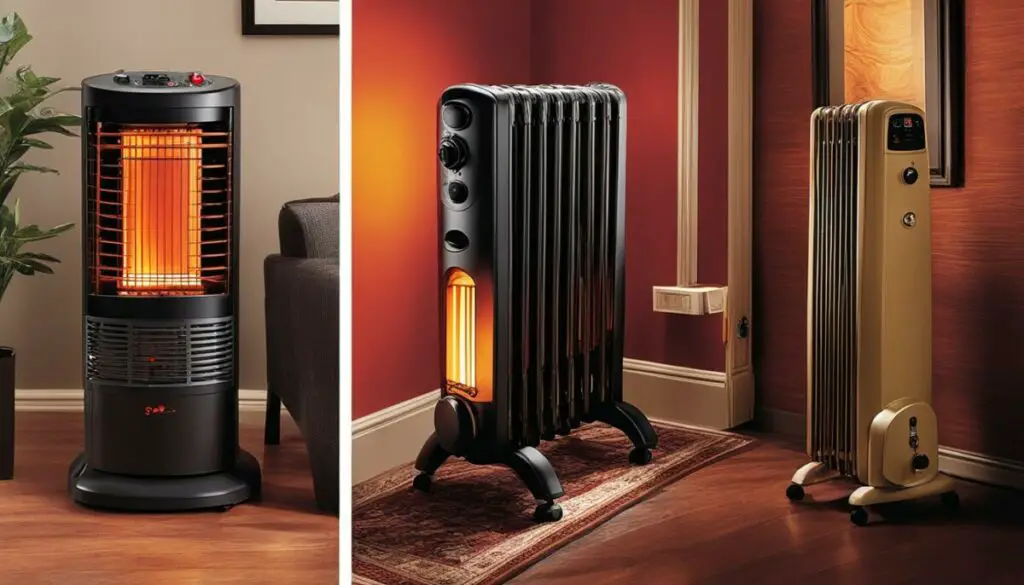Last Updated on 4 months by Francis
When it comes to heating options, there are many factors to consider. One common debate is between infrared heaters and oil filled heaters. Both have their advantages and disadvantages, making it important to understand how they compare to each other.
Infrared heaters work by converting electricity into infrared radiation, which directly transfers thermal energy to objects and people without heating the air in between. On the other hand, oil heaters use electricity to heat oil and distribute warmth through convection. To help you make an informed decision, we’ll examine the pros and cons of each type of heater.
Contents
Key Takeaways:
- Infrared heaters provide quick and direct heating, while oil filled heaters distribute warmth through convection.
- Infrared heaters are lightweight and portable, while oil filled heaters are bulkier.
- Infrared heaters are environmentally safe, while oil filled heaters do not emit harmful gases.
- Consider factors such as room size, heating needs, portability, energy efficiency, and comfort when choosing between the two types of heaters.
- Both infrared heaters and oil filled heaters offer unique benefits, so choose the one that best suits your specific requirements.
What is Infrared Heater?

Infrared heaters are a popular heating solution that utilize electricity to convert it into infrared radiation. This radiation directly transfers thermal energy to objects and people in its path, without heating the air in between. The process is similar to the warmth you feel when standing in the sun. Infrared heaters have gained recognition for their quick and efficient heating capabilities, making them an attractive option for both indoor and outdoor use.
Unlike traditional heaters that rely on convection to heat the air, infrared heaters emit energy that is absorbed by objects, generating immediate warmth. This direct heating method offers several advantages. Firstly, it eliminates the need for warm-up time, providing instant heat as soon as the heater is turned on. Additionally, infrared heaters are efficient, as there is minimal heat loss during the transfer process. This efficiency not only saves energy but also translates to cost savings for the user.
The portability of infrared heaters is another advantageous feature. They are lightweight and compact, allowing for easy movement and placement in different areas of your home or outdoor spaces. Whether you need to warm up a specific room, create a cozy spot on your patio, or keep your garage comfortable during the colder months, infrared heaters can provide the necessary heat wherever you need it.
It is important to note that while infrared heaters offer many benefits, they also have some limitations. One disadvantage is their limited heating capacity. Infrared heaters are best suited for heating smaller areas rather than large rooms or open spaces. Additionally, they may not be as efficient as natural gas alternatives. Although they provide direct heat, they may not be able to achieve the same level of warmth and energy efficiency as a natural gas heating system.
Infrared heaters offer a direct and efficient heating solution by converting electricity into infrared radiation. They provide quick warmth, are lightweight and portable, but have a limited heating capacity compared to natural gas alternatives.
What is an Oil Heater?
An oil heater, also known as an oil-filled radiator, is an electric heater that utilizes oil as a heat transfer medium. These heaters work through the process of convection, where the oil is heated by an internal heating element and then circulated within the heater to distribute warm air into the surrounding space. Oil heaters are highly effective at heating entire rooms and provide even heat distribution, making them a popular choice for residential and commercial spaces.
Oil heaters are designed with a series of cavities or fins that create a larger surface area for effective heat transfer. The heated oil flows through these cavities, emitting heat into the environment. As the warm air rises, cooler air is drawn in and heated, creating a natural convection current that helps maintain a constant room temperature.
One of the advantages of oil heaters is their safety. They do not emit any harmful gases during operation, making them suitable for use in enclosed spaces. Additionally, oil heaters are designed to remain cool to the touch, reducing the risk of accidental burns.
However, it is important to note that oil heaters have some disadvantages. One drawback is that they take longer to heat up compared to infrared heaters. It may take some time for the oil to reach its optimal temperature, resulting in a slower overall heating process. Additionally, oil heaters tend to be bulkier in size and occupy more space compared to their infrared counterparts.
Overall, oil heaters are an effective and safe heating solution for those looking to heat larger areas or maintain a constant room temperature. While they may have a slower heating time and larger physical footprint, their even heat distribution and safety features make them a popular choice for both residential and commercial spaces.
Advantages of Infrared Heaters

Infrared heaters offer numerous advantages that make them a popular choice for efficient and effective heating:
- Quick and Direct Heating: Infrared heaters provide instant warmth by directly heating objects and people in their path, rather than wasting energy heating the surrounding air.
- Spot Heating: These heaters are perfect for spot heating, allowing you to focus the heat exactly where you need it the most, such as a specific area or zone in a room.
- Lightweight and Portable: Infrared heaters are designed to be lightweight and portable, making it easy to move them from room to room, providing heat wherever you go.
- Environmentally Safe: Unlike other heating options, infrared heaters do not emit any harmful gases or pollutants, making them environmentally friendly and safe for indoor use.
Experience the convenience and efficiency of infrared heating for yourself with these innovative heaters.
“Infrared heaters provide quick and direct warmth to keep you cozy during those cold winter months.”
Disadvantages of Infrared Heaters

While infrared heaters offer many advantages, it’s essential to acknowledge their limitations and disadvantages. Understanding these drawbacks can help you make an informed decision when selecting a heating option for your space.
Limited Heating Capacity
Infrared heaters are not suitable for heating large areas or open spaces. Their heating capacity is limited, making them more effective in smaller rooms or targeted heating scenarios. If you need to heat a larger area, such as a spacious living room or an open office floor, infrared heaters may not provide sufficient warmth.
Safety Hazard
One of the potential downsides of infrared heaters is their exposed heating element. This design can pose a safety risk, especially in households with children or pets. It’s crucial to exercise caution and ensure proper placement of the heater to minimize the likelihood of accidental contact with the hot surface.
Less Efficient Than Natural Gas Alternatives
Compared to natural gas alternatives, infrared heaters are generally less efficient in terms of energy consumption. While they convert electricity into infrared radiation and provide direct heat to objects and people, their overall energy efficiency falls short when compared to natural gas heaters. If energy efficiency is a primary concern, exploring natural gas heating options might be more suitable.
Despite these disadvantages, it’s important to note that infrared heaters can still be a viable heating option for specific applications and situations. By carefully considering your heating needs, the size of the area you wish to heat, and your safety requirements, you can determine if an infrared heater is the right choice for you.
Advantages of Oil Heaters

Oil heaters offer numerous advantages that make them a popular choice for heating solutions. Whether you need to warm up a small space or a larger room, oil heaters are designed to meet your heating needs effectively.
Heats the Entire Room: One of the key advantages of oil heaters is their ability to heat the entire room. With their efficient heating mechanism, these heaters distribute warmth evenly, ensuring cozy comfort throughout the space.
Compact and Portable: Oil heaters are compact in size and portable, allowing you to easily move them from one room to another. Their lightweight construction makes them convenient for use in various areas of your home or office.
Energy Efficient: When it comes to energy efficiency, oil heaters are an excellent choice. They operate by heating the oil within the heater, which in turn radiates heat into the surroundings. This targeted heating approach ensures that only the room you are in is warmed up, minimizing energy wastage.
No Need for Refilling: Unlike some heaters that require regular refilling of fuel or gas, oil heaters eliminate the need for refilling. Once filled, the oil inside the heater retains its heat for a long time, allowing you to enjoy hours of warmth without interruption.
With their ability to heat the entire room, compact and portable design, energy efficiency, and no need for refilling, oil heaters offer reliable and convenient heating solutions. Their durability and long-lasting heat retention make them a practical choice for maintaining a comfortable indoor environment. Consider these advantages when deciding on the best heating option for your needs.
Disadvantages of Oil Heaters
While oil heaters have several advantages, they also come with a few disadvantages that need to be considered before making a purchase. These drawbacks include:
- Slow heating: Unlike infrared heaters that provide quick and direct heat, oil heaters take some time to warm up a room. This slower heating process may not be ideal for those who require immediate warmth.
- Slightly more expensive than infrared heaters: Oil heaters tend to be slightly more expensive than their infrared counterparts. Although the price difference is not significant, it is important to consider your budget when comparing the two options.
- Bulky devices: Oil heaters are bulkier in size compared to infrared heaters. Their larger size may limit their portability and versatility in different spaces.
- Need for storage space: Due to their larger size, oil heaters require ample storage space when not in use. This can be a challenge for those with limited storage options or small living spaces.
Despite these disadvantages, oil heaters remain a popular choice for many due to their ability to heat an entire room effectively and efficiently.
| Disadvantages | Oil Heaters | Infrared Heaters |
|---|---|---|
| Heating Speed | Slow | Quick |
| Price | Slightly more expensive | Comparatively affordable |
| Portability | Bulky | Lightweight and portable |
| Storage | Requires space | Requires less space |
Differences Between Infrared and Oil Heaters

Infrared heaters and oil heaters have several differences that make each type suitable for different heating needs and preferences.
Overall Design:
Infrared heaters are smaller and lightweight, making them easy to move around and store. On the other hand, oil heaters are bulkier and require more space.
Heating Speed:
Infrared heaters have a quicker heating speed, providing instant warmth as soon as they are turned on. Oil heaters, however, take some time to heat up and warm the room gradually.
Heating Capacity and Heat Distribution:
When it comes to heating capacity, oil heaters are more efficient at heating larger areas due to their convection heat distribution. In contrast, infrared heaters have a lower heating capacity and heat objects and people directly, making them suitable for spot heating specific areas.
Efficiency:
Oil heaters are generally more energy efficient, as they retain heat for a longer time even after the heater is turned off. Infrared heaters are not as efficient as natural gas alternatives.
Comfort:
Infrared heaters provide direct heat, which can be more comfortable for individuals who prefer targeted warmth. Oil heaters provide convection heat, ensuring even heat distribution throughout the room.
Storage:
Infrared heaters are easier to store due to their compact size. Oil heaters, on the other hand, require more space for storage.
Overnight Use and Safety:
Both infrared heaters and oil heaters can be used overnight, but precautions should be taken to ensure safety. It is important to follow the manufacturer’s instructions and recommendations for safe usage.
Plug-and-Play and Remote Control:
Both infrared heaters and oil heaters can have plug-and-play functionality, allowing for easy setup and use. Additionally, some models may offer remote control options for convenient operation.
Maintenance:
In terms of maintenance, infrared heaters require less maintenance compared to oil heaters. Oil heaters may require occasional cleaning and oil refills to ensure optimal performance.
When deciding between infrared heaters and oil heaters, consider factors such as the size of the room, heating needs, portability, energy efficiency, comfort, storage space, overnight use and safety, plug-and-play options, remote control features, and maintenance requirements. By carefully evaluating these factors, you can choose the heater that best suits your specific requirements.
Features of Infrared Heaters and Oil Heaters
Infrared heaters and oil heaters offer distinct features that cater to different heating needs. Understanding these features will help you make an informed decision when choosing the right heater for your space.
Features of Infrared Heaters:
- Quick and Direct Heating: Infrared heaters provide rapid warmth by directly heating objects and people in their path, rather than heating the air.
- Spot Heating: These heaters are ideal for targeted heating, allowing you to focus the heat in specific areas.
- Lightweight and Portable: Infrared heaters are lightweight and portable, making them easy to move between rooms or even take outdoors.
- Thermostat Controls: Many infrared heaters come with built-in thermostats, allowing you to easily regulate the temperature according to your preference.
- Heat Settings: You can adjust the heat settings on infrared heaters to personalize the warmth in your space.
- Safety Features: Infrared heaters often include safety features such as auto shutoff and overheat protection to ensure safe operation.
Features of Oil Heaters:
- Even Heat Distribution: Oil heaters provide uniform heat distribution throughout the entire room, creating a cozy and comfortable environment.
- Energy Efficient: These heaters only heat the room you are in, making them energy efficient and cost-effective.
- No Need for Refilling: Oil heaters do not require refilling as they utilize the same oil repeatedly, saving you time and effort.
- Retains Heat for a Long Time: Even after turning off the heater, oil heaters retain heat for a longer duration, keeping the room warm.
- Thermostat Controls: Many oil heaters feature adjustable thermostat controls, allowing you to set and maintain your desired temperature.
- Safety Features: Oil heaters are equipped with safety features like auto shutoff and overheating protection to ensure safe usage.
By considering these features, you can choose the heater that best aligns with your heating requirements, room size, portability needs, comfort preferences, and budget.
Which Heater Should You Choose?
When deciding between infrared heaters and oil heaters, it’s essential to consider several factors to make the right choice for your heating needs. Take into account the following:
- Size of the room: Determine the square footage of the space you want to heat. This will help you determine the heating capacity required for effective warmth.
- Heating needs: Consider whether you need quick spot heating or even heat distribution throughout the room. This will play a role in choosing between infrared and oil heaters.
- Portability: If you need a heater that you can easily move around different rooms, consider the lightweight and portable nature of infrared heaters.
- Energy efficiency: Assess the energy efficiency of both types of heaters to ensure you choose a model that will save you money on your energy bills.
- Comfort: Think about whether you prefer the direct heat provided by infrared heaters or the convection heat provided by oil heaters.
- Maintenance: Evaluate the maintenance requirements of each type of heater. Infrared heaters generally require less maintenance compared to oil heaters.
- Budget: Consider your budget and compare the costs of infrared heaters and oil heaters. Determine which option offers the best value for your money.
By carefully evaluating these factors, you can make an informed decision on which heater will best suit your needs.
To further assist you in your decision-making process, here’s a helpful comparison table:
| Factors | Infrared Heaters | Oil Heaters |
|---|---|---|
| Heating Method | Infrared radiation | Oil and convection |
| Heating Speed | Quick | Slower |
| Heating Capacity | Limited for large areas | Efficient for larger areas |
| Portability | Lightweight and portable | Bulkier |
| Energy Efficiency | Varies | Varies |
| Comfort | Direct heat | Convection heat |
| Maintenance | Less maintenance required | Regular maintenance required |
| Price Range | Varies | Varies |
Conclusion
In conclusion, when it comes to choosing between infrared heaters and oil heaters, it’s important to consider your specific heating needs and preferences. Both types of heaters have their advantages and disadvantages, so it’s crucial to weigh the pros and cons before making a decision.
If you prioritize quick and direct heating, spot heating, lightweight portability, and environmental safety, then infrared heaters may be the better option for you. On the other hand, if you value even heat distribution, energy efficiency, and the ability to retain heat for a long time, then oil heaters might be more suitable for your needs.
Ultimately, the choice between infrared heaters and oil heaters depends on the size of the room, your heating requirements, portability needs, energy efficiency goals, comfort preferences, maintenance considerations, and budget constraints. By carefully evaluating these factors, you can make an informed decision and select the heater that best meets your specific requirements.
FAQ
Are infrared heaters better than oil-filled heaters?
Both infrared heaters and oil-filled heaters have their advantages and disadvantages. The choice between the two depends on factors such as room size, portability, energy efficiency, comfort, maintenance, and budget.
What is the difference between infrared heaters and oil-filled heaters?
Infrared heaters convert electricity into infrared radiation to provide quick and direct heating, while oil-filled heaters use convection to distribute warm air throughout the room. Infrared heaters are lightweight and portable, while oil-filled heaters are bulkier. Additionally, infrared heaters have a lower heating capacity and heat distribution compared to oil-filled heaters.
What are the advantages of using infrared heaters?
Infrared heaters offer quick and direct heating, making them ideal for spot heating. They are also lightweight and portable, allowing for easy transport. Furthermore, infrared heaters are environmentally safe as they do not emit any harmful gases.
What are the disadvantages of infrared heaters?
Infrared heaters are not suitable for heating large areas, have an exposed heating element that can pose a safety hazard, and are less efficient compared to natural gas alternatives.
What are the advantages of using oil-filled heaters?
Oil-filled heaters provide even heat distribution, are energy efficient, and can retain heat for a long time even after being turned off. They are also compact and portable, making them easy to move between rooms.
What are the disadvantages of oil-filled heaters?
Oil-filled heaters are slower to heat up compared to infrared heaters, they can be slightly more expensive, and they require storage space due to their bulkier size.
What are the differences between infrared heaters and oil-filled heaters?
In terms of overall design, infrared heaters are smaller and lighter, while oil-filled heaters are larger and heavier. Infrared heaters have a quicker heating speed, but a lower heating capacity and heat distribution compared to oil-filled heaters. Additionally, infrared heaters provide direct heat, while oil-filled heaters provide convection heat.
What features do infrared heaters and oil-filled heaters have?
Infrared heaters are known for their quick and direct heating, while oil-filled heaters provide even heat distribution. Both types of heaters offer options for thermostat controls, heat settings, and safety features such as auto shutoff and overheat protection.
What factors should I consider when choosing between infrared heaters and oil-filled heaters?
Consider factors such as the size of the room, heating needs, portability, energy efficiency, comfort, maintenance, and budget to determine which heater will best suit your needs.
No conclusion section was requested.




.jpg)



